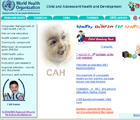Inter-country demonstration training course on "Caring for the sick child in the community", Sana'a, Yemen, 21 - 26 March 2010
 This course, jointly supported by WHO and UNICEF, aimed to expose participants not only to the classical training approach used in the global materials for community health workers (CHWs) on "Caring for the sick child in the community"—which much rely on reading as a key method for the learner to acquire knowledge—but also to other interactive, innovative training methods requiring minimal or no reading. The latter methods were developed by the Regional Office to better suit CHWs with limited literacy levels and no health background such as those targeted in countries in the Region, as recommended in the previous workshop in November. In that workshop, the participating countries had confirmed interest in increasing access to child care through CHWs as a means of reducing under-five mortality and thus contributing to achieving the related Millennium Development Goal (MDG) #4 and identified the need for adaptation of the WHO/UNICEF CHW training. The course held in Sana’a was also an opportunity to further discuss policy and strategy needs for CHWs, review and update the plans developed in the previous workshop and agree on the next steps. It was attended by 25 participants from 6 countries (Afghanistan, Egypt, Iraq, Sudan, Syrian Arab Republic and Yemen), including staff of ministries of health, academic institutions, development cooperation agencies and projects (JICA/Yemen and BASICS/Afghanistan), UNICEF country offices and WHO at all levels. The course content addressed the main causes of deaths in under-5 children, such as pneumonia, diarrhoea, malaria and malnutrition. Key policy and strategic issues were reviewed and discussed to place training within a health system support context. Participants strongly recommended that the Regional Office should continue the development of a well-designed CHW training facilitator guide and related materials.
This course, jointly supported by WHO and UNICEF, aimed to expose participants not only to the classical training approach used in the global materials for community health workers (CHWs) on "Caring for the sick child in the community"—which much rely on reading as a key method for the learner to acquire knowledge—but also to other interactive, innovative training methods requiring minimal or no reading. The latter methods were developed by the Regional Office to better suit CHWs with limited literacy levels and no health background such as those targeted in countries in the Region, as recommended in the previous workshop in November. In that workshop, the participating countries had confirmed interest in increasing access to child care through CHWs as a means of reducing under-five mortality and thus contributing to achieving the related Millennium Development Goal (MDG) #4 and identified the need for adaptation of the WHO/UNICEF CHW training. The course held in Sana’a was also an opportunity to further discuss policy and strategy needs for CHWs, review and update the plans developed in the previous workshop and agree on the next steps. It was attended by 25 participants from 6 countries (Afghanistan, Egypt, Iraq, Sudan, Syrian Arab Republic and Yemen), including staff of ministries of health, academic institutions, development cooperation agencies and projects (JICA/Yemen and BASICS/Afghanistan), UNICEF country offices and WHO at all levels. The course content addressed the main causes of deaths in under-5 children, such as pneumonia, diarrhoea, malaria and malnutrition. Key policy and strategic issues were reviewed and discussed to place training within a health system support context. Participants strongly recommended that the Regional Office should continue the development of a well-designed CHW training facilitator guide and related materials.
Pakistan accelerates IMCI implementation
The latest data provided by the Federal Ministry of Health of Pakistan indicate that IMCI implementation accelerated in the country in 2009. Although formally endorsed by the Ministry of Health at the end of 1998, it was not until 2006 that the IMCI strategy started being implemented at a faster pace in the country. In the 4-year period from 2006 to 2009, the percentage of health facilities with staff trained in IMCI increased to 16.5% (2009) from 2% (2006), while the total number of health providers trained in IMCI reached 2542 by the end of 2009 from 385 (end of 2005), a 560% increase. While the proportion of PHC facilities implementing IMCI remains low and more efforts are required to provide access of the child health population to IMCI quality care, this trend is an encouraging development. An average of 14 IMCI training courses per year were conducted from 2005 to 2008, while the number of courses reported in 2009 went up to 51 during the year. Improved availability of funds provided by the Government and contributions by partners and initiatives to IMCI (GAVI-Health Systems Strengthening, USAID-funded Pakistan Initiative for Mothers and Newborns or PAIMAN, Save the Children US, etc.), strengthened institutional capacity in the provinces to conduct IMCI training and the strong interest and advocacy by senior paediatricians, the Pakistan Paediatric Association and teaching institutions are likely to have contributed to the increased implementation in 2009. One third of under-five deaths in the Eastern Mediterranean Region are estimated to occur in Pakistan and over one third of all under-five deaths in Pakistan are due to largely preventable causes such as diarrhoeal diseases, pneumonia and measles occurring in the post-neonatal period, which are well addressed in the IMCI strategy. Accelerated efforts are needed in the country to be able to get closer to the Millennium Development Goal #4 on reduction of under-five mortality by two thirds in 2015 compared with the 1990 levels.
5th birthday of the CAH website!
 Since its launching on 7 April 2005 on occasion of the World Health Day “Make every mother and child count”, the website has expanded to include more information on child health activities in the Region and respond to users’ needs. A French version of the news has also been added.
Since its launching on 7 April 2005 on occasion of the World Health Day “Make every mother and child count”, the website has expanded to include more information on child health activities in the Region and respond to users’ needs. A French version of the news has also been added.
The CAH website aims at sharing information on the work on the health and psychosocial development of children under-5 carried out by the Regional Office, and related activities and initatives promoted and carried out in countries in the Region. It is intended for public health and programme managers, academia, civil organizations and nongovernmental organizations, students and anyone interested in public child health issues, with special focus on the Eastern Mediterranean Region.
The CAH website provides detailed information on the coverage of child health activities at different levels in countries in the Region—especially the implementation of the Integrated Management of Child Health (IMCI) strategy—, the systematic approach followed in countries during implementation, the technical guidelines specifically adapted to each country, the tools developed and used at regional and country levels to plan, collect information, supervise and evaluate, and data on outcomes from structured follow-up visits and surveys. Specific sections describe the evolution of IMCI over the years in the Region and its relationship with primary health care, IMCI in pre-service education, health systems issues, the process and guidelines to develop national child health policies, the child health-related Millennium Development Goals, research work, and advocacy initiatives. A library of resources which have resulted from CAH work in the Region, including reports and documents, is also provided.
A set of publications on IMCI pre-service education – a major undertaking by this Regional Office – is expected to be posted on the website soon. “Stay tuned!”


